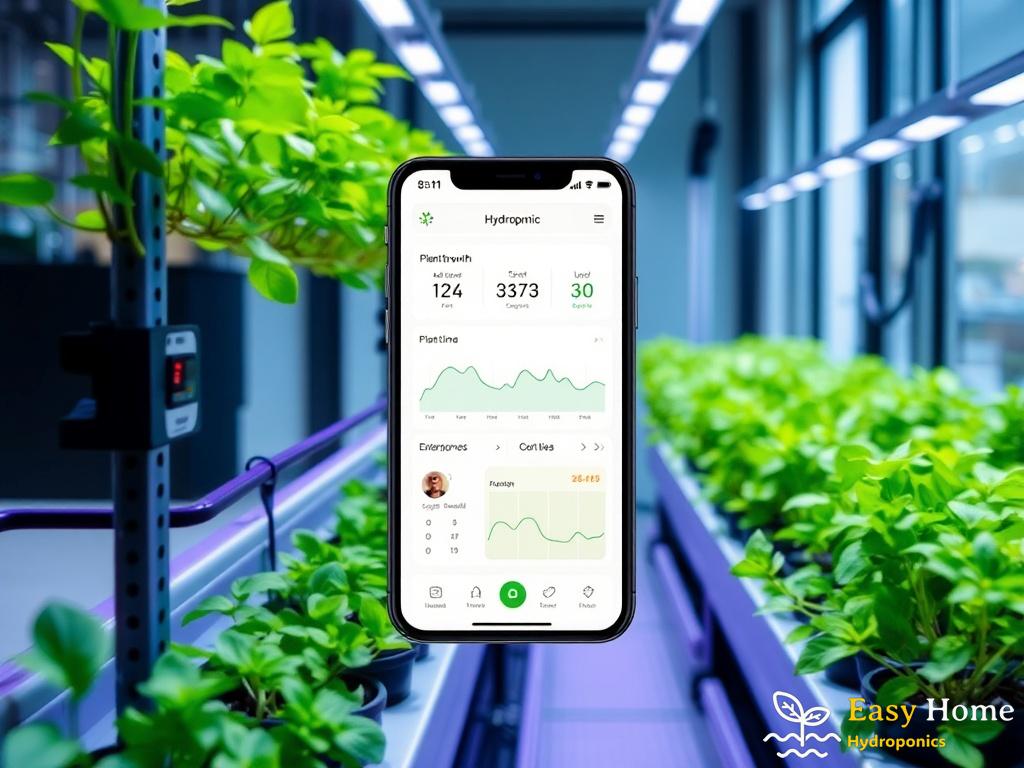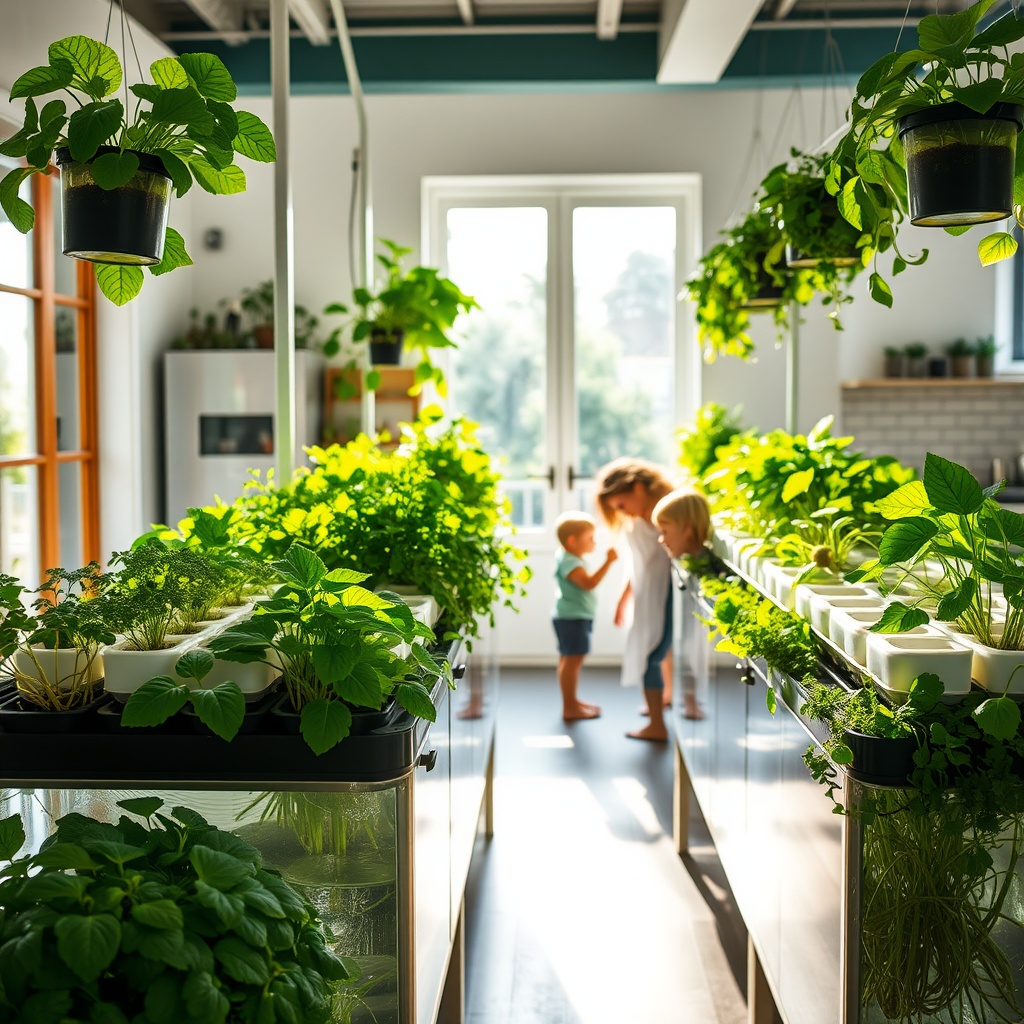Smartphone Sensors: The Future of Hydroponic Monitoring

The Rise of Smart Hydroponics
As the world embraces sustainable agriculture, hydroponics stands out as a revolutionary method for growing plants without soil. With the integration of technology, particularly smartphones, this growing trend is becoming increasingly sophisticated. Smartphone sensors are now central to the evolution of hydroponic monitoring, enabling home gardeners and commercial growers alike to optimize their systems with ease.
Revolutionizing Monitoring with Sensors
Smartphones are equipped with a variety of sensors that can transform the way we monitor hydroponic systems. From temperature and humidity sensors to pH and nutrient level detectors, these tools provide real-time data that empower users to make informed decisions.
Imagine having the ability to check the nutrient levels in your hydroponic solution or the temperature of your grow area, all from the palm of your hand. This convenience is not just a luxury; it’s becoming a necessity for successful hydroponic farming.
| Sensor Type | Functionality | Benefits |
|---|---|---|
| Temperature Sensors | Monitors ambient temperature | Ensures optimal growth conditions |
| pH Sensors | Measures acidity of the nutrient solution | Prevents nutrient lockout |
| Humidity Sensors | Tracks moisture levels in the air | Prevents mold and diseases |
| Nutrient Sensors | Analyzes nutrient concentration | Optimizes feeding schedules |
Future Trends and Innovations
The future of hydroponic monitoring is bright, with smartphone technology leading the charge. As innovation continues, we can expect to see advancements such as enhanced AI algorithms that predict plant needs, integration with smart home systems, and even augmented reality features that guide users through their hydroponic journey.
In conclusion, the convergence of smartphone sensors and hydroponics is setting the stage for a more efficient and user-friendly approach to indoor and urban farming. With the right tools and technologies, anyone can become a successful hydroponic gardener.
User-Friendly Interfaces: Designing Apps for All Growers

In the realm of hydroponics, where precision is key and every detail matters, the importance of user-friendly app interfaces cannot be overstated. With the rise of smartphone technology, growers—from novices to seasoned experts—are seeking applications that simplify the complexities of hydroponic systems. A well-designed interface not only enhances user experience but also promotes effective management of plants, leading to healthier crops and higher yields.
Creating Intuitive Experiences
The central goal of any hydroponic monitoring app should be to create an intuitive experience that caters to users of all skill levels. This involves understanding the unique needs of both amateur gardeners and professional growers. A successful app must bridge the gap between advanced functionalities and ease of use, ensuring that every grower can navigate the features without feeling overwhelmed.
Key Features for Enhanced Usability
To achieve this, developers are focusing on several key features that enhance usability:
- Visual Dashboards: Clear and informative dashboards that present data visually, allowing users to quickly grasp the status of their hydroponic systems.
- Customizable Alerts: Notifications tailored to user preferences, ensuring that growers receive timely information on parameters like nutrient levels and environmental conditions.
- Guided Tutorials: Step-by-step tutorials or onboarding processes that educate users on how to use the app effectively, making it accessible for beginners.
Incorporating Feedback for Continuous Improvement
Moreover, the design process should not be static. Continuous feedback from users plays a vital role in refining app functionalities. Developers can implement features based on user suggestions, ensuring that the app evolves alongside the needs of the hydroponic community. This feedback loop fosters a sense of ownership among users and encourages a loyal following.
Ultimately, as hydroponic system monitoring apps become more prevalent, the emphasis on user-friendly interfaces will pave the way for a new generation of growers. By making technology accessible and straightforward, we can empower more individuals to embrace sustainable practices and contribute to a greener future.
Data Analytics: Turning Numbers into Nutrient Success
In the fast-paced world of hydroponics, data is king. With the rise of smartphone monitoring applications, the ability to collect and analyze vast amounts of data has never been easier. Growers are no longer just managing their plants; they are now equipped with the tools to harness the potential of data analytics, transforming raw numbers into actionable insights that guarantee nutrient success.
Transforming Raw Data into Actionable Insights
The challenge lies in turning complex data sets into meaningful information that can drive better growing decisions. Modern hydroponic apps are equipped with sophisticated data analytics capabilities that provide growers with the insights needed to optimize their systems. From tracking nutrient levels to analyzing environmental factors, these apps can reveal trends that are pivotal for the health of the crops.
Key Metrics to Monitor for Optimal Growth
To effectively harness the power of data analytics, growers should focus on several key metrics that can significantly influence plant health and yield. Monitoring these metrics can help in making informed decisions that lead to nutrient success:
- Nutrient Concentration: Regular analysis ensures plants receive the right balance of nutrients.
- pH Levels: Maintaining optimal pH is crucial for nutrient uptake.
- Temperature: Fluctuations can affect plant growth rates and overall health.
- Humidity: Monitoring moisture levels helps prevent diseases and optimize growth conditions.
- Light Intensity: Ensures plants get enough light for photosynthesis.
By keeping an eye on these metrics, growers can make timely adjustments to their hydroponic systems, ensuring that their plants thrive. The integration of data analytics into hydroponic apps means that growers no longer have to rely solely on intuition; they can now back their growing strategies with hard data.
Elevating Grower Knowledge with Predictive Analytics
As technology continues to advance, the future of hydroponic monitoring apps looks promising. Predictive analytics is emerging as a game changer, allowing growers to anticipate plant needs before issues arise. Utilizing machine learning algorithms, these apps can analyze historical data and predict future trends, enabling proactive management rather than reactive adjustments. This shift in approach not only enhances crop yields but also fosters a deeper understanding of plant dynamics.
In summary, data analytics is not just about numbers—it’s about transforming those numbers into knowledge that drives success in hydroponic systems. As smartphone technology evolves, the potential for data-driven decision-making in hydroponics will continue to grow, empowering more individuals to excel in sustainable agriculture.
Remote Control: Managing Your Hydroponics from Anywhere
As technology continues to weave itself into the fabric of our daily lives, the ability to manage hydroponic systems remotely has emerged as a game-changing trend. Growers are no longer tethered to their gardens, thanks to smartphone applications that offer remote control capabilities. Imagine being able to monitor your plants’ health, adjust nutrient levels, and even control environmental conditions—all from your smartphone, no matter where you are. This level of convenience opens up a world of possibilities for hydroponic enthusiasts, both amateur and professional alike.
Empowering Growers with Remote Access
Remote control features in hydroponic monitoring apps empower users to take charge of their growing environments like never before. With the touch of a button, growers can access real-time data from their systems, ensuring optimal conditions are maintained around the clock. This capability is particularly beneficial for those who travel frequently or have multiple growing sites. No longer do you need to worry about rushing home to check on your plants; your smartphone can do the heavy lifting for you.
Key Features of Remote Hydroponic Management
Below is a list of essential features that make remote control an indispensable tool for hydroponic gardeners:
- Real-Time Monitoring: Instant access to data such as nutrient levels, pH balance, and environmental conditions ensures you stay informed.
- Automated Adjustments: Advanced apps can automatically tweak settings based on real-time data inputs, creating an optimal growing environment without manual intervention.
- Alerts and Notifications: Customizable alerts keep you updated on critical changes, such as sudden temperature drops or nutrient deficiencies, allowing for immediate action.
- Remote Access Controls: Turn on or off pumps, lights, and other equipment remotely to conserve energy or respond to unexpected events.
These features not only enhance the overall growing experience but also minimize the risk of crop failure due to human oversight. By harnessing the power of remote management, growers can enjoy peace of mind knowing their hydroponic systems are being monitored and adjusted in real-time.
A Future Without Boundaries
Looking ahead, the trend of remote control in hydroponic monitoring apps is poised to evolve even further. As connectivity and AI technologies improve, we can anticipate smart systems that learn from user habits and environmental conditions to optimize growth automatically. Imagine a world where your hydroponic system anticipates your needs, adjusting parameters based on historical data and predictive analytics, all while you sip coffee in a different city.
In conclusion, the integration of remote control capabilities in hydroponic monitoring apps represents a significant leap forward in the accessibility and efficiency of urban farming. With these tools at their fingertips, growers can cultivate their green thumb from virtually anywhere, transforming the way we think about gardening in the modern age.
Community Features: Connecting Growers Through Apps
As the world of hydroponics continues to flourish, the importance of community engagement among growers has never been more evident. With the rise of smartphone apps tailored for hydroponic monitoring, these platforms are not only revolutionizing plant care but also fostering a vibrant community of enthusiasts. By integrating social features into these applications, growers can share experiences, seek advice, and build connections that enhance their hydroponic journey.
Building a Network of Knowledge
One of the most exciting aspects of community-oriented hydroponic apps is their ability to create a collaborative environment. Growers can participate in forums and discussion boards, where they can exchange tips and troubleshoot common issues. This interaction not only enriches the individual grower’s knowledge but also cultivates a sense of belonging within the hydroponic community. For instance, users can post photos of their setups, share their successes, and even discuss challenges they face, allowing others to learn from real-life experiences.
Engagement Through Gamification
Many of these apps incorporate gamification elements that encourage users to engage regularly and share their progress. By earning badges for milestones such as successful harvests or maintaining optimal nutrient levels, growers are motivated to stay active within the app. This playful competition can lead to increased user engagement, as growers not only track their progress but also compare achievements with their peers. It’s a win-win situation that promotes learning and camaraderie among users.
Localized Support and Events
Community features can also extend to localized support networks, where users can connect with fellow growers in their area. This opens the door for in-person meetups, workshops, and events that can further enhance the learning experience. Imagine attending a local hydroponics workshop organized through your app and connecting with other passionate growers who share similar interests. Such events not only foster deeper connections but also allow for the exchange of local tips and techniques that cater specifically to the regional climate and conditions.
Paving the Way for Future Innovations
As technology continues to evolve, we can expect community features in hydroponic apps to become even more sophisticated. Future innovations may include virtual reality meetups, where users can immerse themselves in a shared digital space to discuss techniques and showcase their setups. Additionally, AI-driven matchmaking could connect growers based on their specific interests or challenges, leading to even more tailored advice and support.
In summary, the integration of community features within hydroponic monitoring apps is transforming the way growers interact and learn. By fostering connections, encouraging engagement, and supporting localized networks, these applications are paving the way for a more inclusive and knowledgeable hydroponic community.




